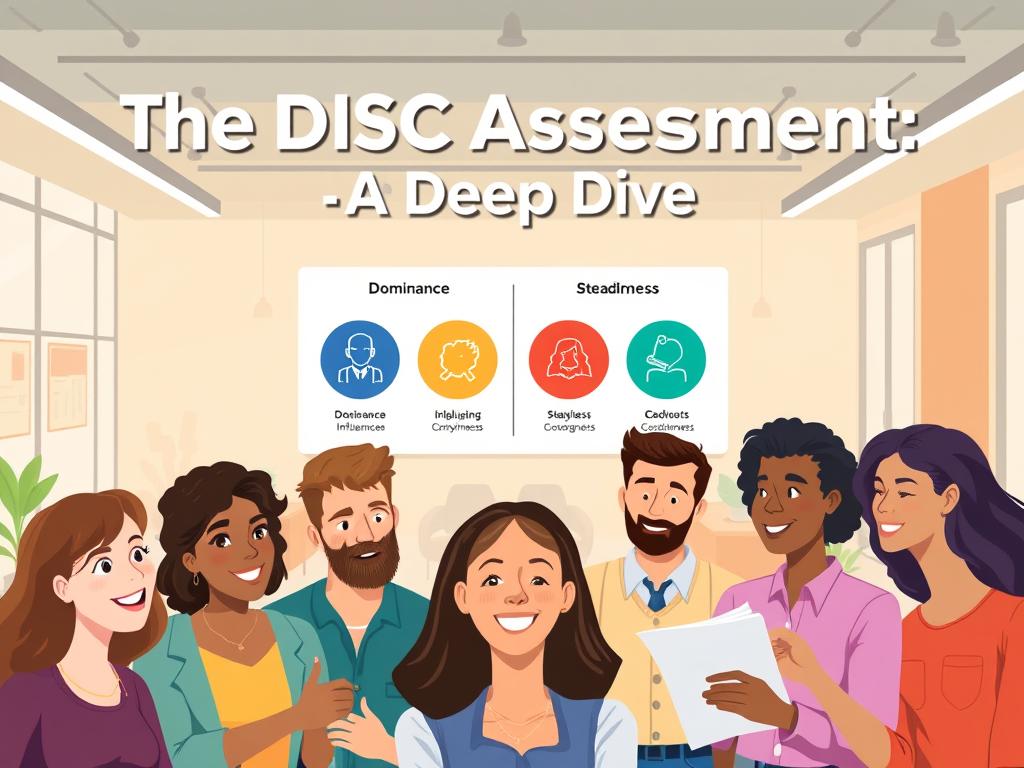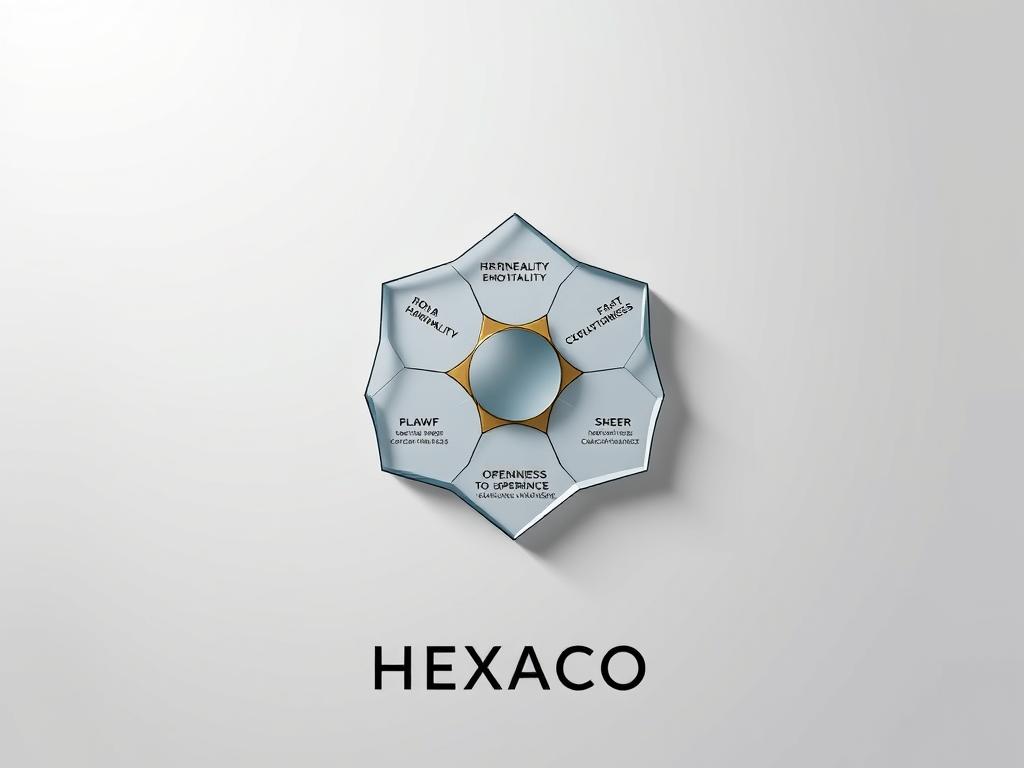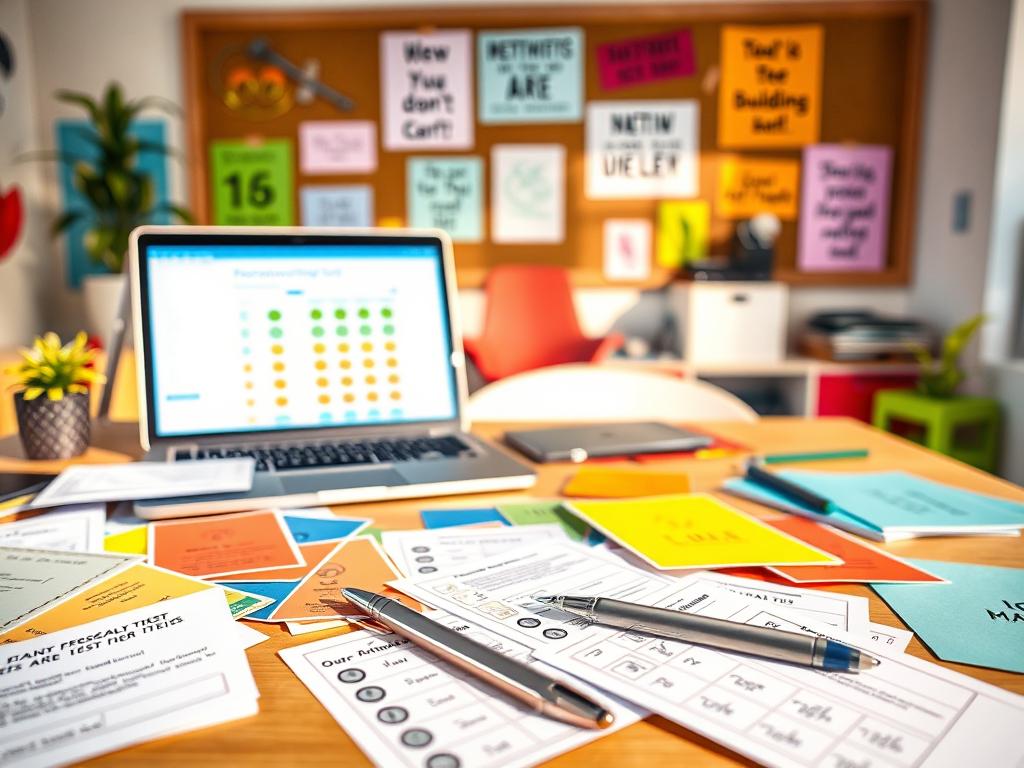Workplaces are finding new ways to bring teams together. Fun Personality Tests for Work are a hit because they mix excitement with teamwork. They help people understand themselves better and how they work with others.
These quizzes give employees new views on working with their colleagues. One quiz can start important talks that make everyone feel better and work harder. Team members with different skills learn to help each other, making the workplace better.
Overview of Personality Tests in the Workplace
Companies use many tests to check on staff traits, behaviors, and what drives them. A 2021 HBO Max and CNN documentary raised questions about fairness. But, experts from the Society for Industrial and Organizational Psychology say they can be used wisely.
When used right, these tools help build teams and grow careers.
Importance of Personality Assessments
Personality tests help us understand our strengths and weaknesses. Studies show they can help make hiring more diverse. Big companies use Fun Personality Tests for Work to help leaders find the right qualities.
Qualities like being open and agreeable are key for team success.
Types of Personality Tests
Some tests, like the Big Five, are backed by science. Others, like quick career quizzes, give fast insights into how we communicate and feel. These tests show how people handle work challenges and team work.
Benefits for Employees and Employers
Workers feel they’re growing by learning about themselves. Employers see better team fit and less turnover. This leads to better teamwork and faster innovation.
Understanding Myers-Briggs Type Indicator (MBTI)
Many companies use the MBTI to learn about how people communicate and make decisions. It’s a key tool in understanding workplace personalities. Every year, two million U.S. adults take the MBTI, showing its wide appeal. It breaks down into 16 personality types based on Carl Jung’s ideas.
The Four Dichotomies Explained
Introversion vs. Extraversion looks at where people get their energy. Sensing vs. Intuition shows how they gather information. Thinking vs. Feeling deals with how they make decisions. And Judging vs. Perceiving is about how they manage tasks. These pairs help form well-rounded teams.
How MBTI Enhances Team Dynamics
Leaders can see what employees are good at, like solving problems or setting goals. Big companies use this to solve conflicts and boost respect. It leads to better teamwork and valuing different views.
Limitations of MBTI in Work Settings
Some question if the MBTI really shows who will do well at a job. People might get different results, raising doubts about its accuracy. Relying too much on it can lead to stereotypes. But, using it wisely and talking openly can help avoid these issues.
The DISC Assessment: A Deep Dive
The DISC framework shows four main traits: Dominance, Influence, Steadiness, and Compliance. It looks at how we act and how we work with others. It’s a fun way to learn about ourselves and our teams at work.

Explanation of the DISC Model
William Moulton Marston first came up with the DISC model. It looks at how driven we are (D) and how social we are (I). It also finds out who is steady (S) and who likes to follow rules (C).
This model helps us understand ourselves better, especially when things change. It makes us more aware of our own strengths and weaknesses.
Application in Team Collaboration
Teams use DISC to work better together. By knowing each other’s strengths, they can do their jobs faster and smoother. Managers can see who’s best at setting goals and who keeps things running smoothly.
This helps teams work together better and feel more connected. Everyone knows their role and can do their best.
Common Misconceptions
Some think DISC says you can’t change. But it’s all about growing and learning. It works well with other tools to give a full picture of each person.
This helps teams understand each other better. It’s a way to improve how we work together and build stronger relationships.
The Enneagram: A Unique Approach to Personality
This model breaks down personality into nine types. It shows what drives our actions. Over 10,000,000 people have taken Truity’s Enneagram Test, giving it a 4.9-star rating.
Big names like Coca-Cola and Boeing see its value. The test is quick, taking 10-15 minutes. It offers free basic results or a detailed premium report.
It looks deeper into our motivations. This makes it different from other career quizzes.
Overview of the Nine Types
Each type has its own view of life. People often feel closest to one type but also share traits with others. This makes understanding more complex and less one-dimensional.
- Type 1: Reformer
- Type 2: Helper
- Type 3: Achiever
- Type 4: Individualist
- Type 5: Investigator
- Type 6: Loyalist
- Type 7: Enthusiast
- Type 8: Challenger
- Type 9: Peacemaker
Integrating Enneagram into Company Culture
Some companies hold workshops to improve teamwork. They use the Enneagram to understand each other better. This helps in solving conflicts and building trust.
Enneagram Insights for Leadership
Leaders gain from knowing themselves and their team. The Enneagram helps them make better decisions. It leads to stronger teamwork and better results.
StrengthsFinder: Identifying Core Strengths
Leading companies use StrengthsFinder, now called CliftonStrengths, to find natural talents. It ranks 34 themes and offers coaching to help teams work better together.
People get a new look at their work personalities with personalized reports. These reports show their top five strengths. Managers who use these talents see better work and happier teams.
This method is a top Fun Personality Test for Work. It helps departments find their purpose. Many leaders use it to make work better and motivate their teams.
StrengthsFinder is a top test because it shows different work personalities. It helps teams use their best qualities. This makes everyone happier and more productive.
How StrengthsFinder Works
People take tests to see their traits, like communication or thinking ahead. The system finds their top talents. It helps them grow by supporting them and making them think about their strengths.
Using Strengths to Foster Team Effectiveness
Teams get stronger when they do tasks that match their talents. Leaders who value these talents create a place where everyone can shine. This makes skill gaps less noticeable.
Real-World Examples from Successful Teams
Companies like Gallup show how recognizing strengths leads to success. Happy workplaces have fewer fights, stronger bonds, and keep moving forward together.
The HEXACO Model: An Alternative Framework
Companies looking for deeper insights use the HEXACO model. It has six dimensions, including honesty and humility. This is different from older five-factor systems. Scotiabank and others use it to find the right talent and improve work harmony.

What Sets HEXACO Apart from Others
HEXACO adds honesty-humility to the five-factor model. This new area focuses on character and ethics. Studies show that honest communication leads to less conflict and better teamwork.
- Honesty-Humility
- Emotionality
- Extraversion
- Agreeableness
- Conscientiousness
- Openness to Experience
Practical Uses in Organizational Development
Businesses use HEXACO to match roles with traits. They ask specific questions during hiring. This helps in leadership programs too, focusing on traits like conscientiousness and extraversion.
Research Support for HEXACO
Research shows a 100-item inventory is good for self-assessment. It looks at moral and social aspects. Many find it a fun way to understand how ethics impact work and company culture.
Big Five Personality Traits: A Comprehensive Analysis
The Big Five model, also known as the OCEAN framework, shows the main traits that shape how we act at work. People like Gordon Allport and Raymond Cattell helped us understand this. Studies in over 50 cultures prove it’s true. This detailed resource explains how each trait affects job performance. It’s why the Big Five is used in Fun Personality Tests for Work and career quizzes.
Breakdown of the Five Factors
- Openness: Loves new ideas and learning
- Conscientiousness: Organized and reliable
- Extraversion: Loves being around people and active
- Agreeableness: Kind and likes to work together
- Neuroticism: Stays calm under stress
Big Five Assessment Tools Available
Many sites offer free tests, like 60-question ones and 30-trait analyses. These tests help find the right job for you based on your personality.
Implications for Team Performance
Managers often put the most organized people in charge of projects. They also put outgoing people in roles where they meet clients. This makes teams happier and more united. It helps everyone grow by showing their strengths and what they can work on.
Fun and Informal Personality Tests
Employers use Fun Personality Tests for Work to connect with their teams. These quizzes start conversations and make team activities fun. Over 73,930 companies, like FedEx and Amazon, use them to show workplace personalities and share funny facts.
Fun team-building traditions help colleagues bond. Social media quizzes reveal fun facts quickly. They may not be exact, but they bring laughter and get everyone involved.
Buzzfeed Quizzes as Icebreakers
Buzzfeed quizzes make teams excited with fun topics. Employees talk about their results, learn new things, and find common interests. This sparks friendly chats.
Online Tools for Team Building
Online tools offer casual tests for team building. Short games fit today’s workplaces, aiming for inclusivity and warmth. They make group interactions better.
Creative Personality Assessments
Workshops use fun tests like color or emoji activities. Leaders lead these on team-building days or socials. This creates a supportive space for real talks and strong bonds.
Implementing Personality Tests in the Workplace
Companies see a 70% better success rate when employees use their strengths. This method boosts engagement and makes Fun Personality Tests for Work more effective. A good self-assessment helps staff find their traits and match them with work goals.

Timing and Context for Administration
Introduce these tools at key times like onboarding or team-building. Tests like CliftonStrengths find when team members shine the most. They show how everyone can contribute their best.
Ensuring Confidentiality and Trust
A clear privacy policy stops fear of bad outcomes. Employees share honestly if they know their info is safe. Talking openly about the test’s purpose helps everyone participate fully.
Following Up on Results
Regular check-ins make insights from tests even more valuable. Leaders and HR get to use the data for feedback and growth plans. This keeps the insights current and useful.
Interpreting Test Results Effectively
Fun Personality Tests for Work and career quizzes give valuable insights. Yet, many groups have mixed feelings. Some say the results are too broad. About 50% doubt using these insights in real work.
But, talking openly about the results can help. It makes people feel better.
Understanding Different Personality Types
It’s key to know each person’s strengths and how they communicate. A study showed 33 people wanted clear explanations of traits like introversion and analytical thinking. They learned how different personality types, like MBTI or DISC, affect teamwork.
Discussing Results in Teams
Sharing insights builds trust and understanding. Some teams discuss group data in workshops. This keeps things private but shows common themes.
One person shared how StrengthsFinder results led to open talks. These talks helped plan projects and spark new ideas.
Actionable Steps After Evaluating Results
- Host brief follow-up sessions where each person shares a key lesson from the test.
- Pair team members with different traits to improve teamwork and brainstorming.
- Review project workflows to see how personality differences can make things more efficient.
Case Studies: Successful Implementation of Personality Tests
Real examples show how Fun Personality Tests for Work change workplaces. They help teams talk better and work together. Hogan works with almost 60 countries and 80 percent of Fortune 500 companies.
It has eight different work areas and a rooftop for outdoor work. This makes employees happy and productive.
Popular personality tests for employers help tech firms. They help developers and managers work better together. This cut down on leaving jobs and made projects run smoother.
Example from a Technology Company
A top developer group made talking easier by sharing test results. They learned to give tasks that fit their skills. This made software come out faster and made everyone happier.
Insights from a Non-Profit Organization
A nonprofit used DiSC to train volunteers. They learned to talk in ways that worked for everyone. This made projects better and made people less stressed.
Results of Implementing Personality Assessments
Employers save time with tests from Aon. They get good results in under 30 minutes. These tools help teams work better together in a changing world.
Conclusion: Finding the Right Fun Personality Test
Many companies use fun personality tests to boost team spirit and find hidden talents. The Myers-Briggs Type Indicator is a favorite, with 93 questions and used by 80% of Fortune 500 firms. Others like career quizzes to spark new ideas and help people find their strengths in the workplace.
The Importance of Tailoring Tests to Team Needs
Every team is different, so one test might not fit all. Some teams prefer the DISC with 28 questions, while others like the 180-question Caliper Profile for deeper insights. Choosing the right test can make teamwork better, reduce misunderstandings, and meet company goals.
Encouraging Open Communication
Being open about why these tests are used builds trust. Talking openly about the results helps teams work better together. Teams that talk honestly tend to have stronger bonds, leading to happier employees and better job retention.
Continuous Evaluation and Adaptation
Regular updates keep tests relevant. Some teams do tests again or try new ones when roles change or projects grow. This way, companies can always use the best tests for their needs, helping everyone succeed in the long run.
FAQ
Q: How do “fun” personality tests differ from formal assessments like MBTI or DiSC?
Q: Can career quizzes really help identify workplace personalities?
Q: What is the main benefit of using multiple assessments instead of just one?
Q: How can organizations ensure responsible use of these personality tests?
Q: Are the results of informal quizzes still valuable for team building?
Q: What role do career quizzes play in ongoing professional development?
Q: How do employers decide which personality test suits their company best?
Source Links
- https://www.linkedin.com/business/talent/blog/learning-and-development/workplace-personality-tests-that-can-improve-your-team – 7 Workplace Personality Tests That Can Help Improve Your Team | LinkedIn
- https://www.bloomgrowth.com/blog/the-7-best-personality-assessments-for-the-workplace/ – The 7 best personality assessments for the workplace
- https://alis.alberta.ca/plan-your-career/learn-more-about-yourself/fun-personality-tests-to-guide-your-career/ – Fun Personality Tests to Guide Your Career – alis
- https://www.ddiworld.com/blog/how-to-use-personality-tests-in-the-workplace – How to Use a Personality Test in the Workplace
- https://lattice.com/articles/do-personality-tests-belong-in-the-workplace – Do Personality Tests Belong in the Workplace? | Article | Lattice
- https://www.verywellmind.com/the-myers-briggs-type-indicator-2795583 – Myers-Briggs Type Indicator: The 16 Personality Types
- https://www.themyersbriggs.com/en-US/Campaigns/All-About-the-MBTI-Assessment – All About the Myers-Briggs (MBTI) Assessment
- https://www.truity.com/test/type-finder-personality-test-new – The TypeFinder® Personality Test
- https://www.48days.com/disc-profile-explained/ – You’ve Taken Your DISC Personality Assessment, Now What? DISC Profile Explained
- https://www.powersresourcecenter.com/blog/an-intro-to-disc-assessments – An Introduction to DiSC Assessments — PRC
- https://high5test.com/best-disc-personality-tests/ – 7 Best DISC Assessment Tests in 2024 (Free & Paid)
- https://www.truity.com/test/enneagram-personality-test – The Enneagram Personality Test
- https://professionalleadershipinstitute.com/resources/a-guide-to-the-enneagram-personality-test/ – A Guide To The Enneagram Personality Test: Origins, Types, And Spirituality
- https://www.cincinnatimagazine.com/article/using-the-enneagram-at-work/ – Using the Enneagram at Work – Cincinnati Magazine
- https://www.teamdynamics.io/blog/top-5-alternatives-to-cliftonstrengths-workplace-personality-tests – Top 5 Alternatives to CliftonStrengths: Workplace Personality Tests
- https://www.trinet.com/insights/the-best-personality-and-strengths-tests-for-work – The Best Personality and Strengths Tests for Work
- https://kevinscolaro.com/what-is-the-hexaco-personality-test – What is the HEXACO Personality Test and Why You Need It to Grow Your Business
- https://www.jobtest.org/learn/personality-test-for-jobs – 10 Personality Tests for Choosing the Right Career Path
- https://www.workstyle.io/best-personality-test – The 23 Best Personality Tests In Ranking Order (2025 Update) – WorkStyle
- https://www.verywellmind.com/the-big-five-personality-dimensions-2795422 – What Are the Big 5 Personality Traits?
- https://www.truity.com/view/tests/big-five-personality – Big Five Personality Tests
- https://teambuilding.com/blog/personality-tests – Personality Tests: Quick, Fun, & Free for Work
- https://www.preemploymentassessments.com/blog/popular-personality-tests/ – Best Personality Tests for Effective Pre-Employment Assessments
- https://carolineadamscoaching.com/blog/how-to-use-personality-assessments-in-the-workplace – How to Use Personality Assessments In the Workplace — Caroline Adams Coaching
- https://www.deepersignals.com/blog/how-to-use-personality-tests-for-team-building – Deeper Signals | How to Use Personality Tests for Team Building
- https://ask.metafilter.com/363762/Personality-testing-in-the-workplace – Personality testing in the workplace
- https://www.fieldengineer.com/article/workplace-personality-tests/ – Understanding the Different Types of Workplace Personality Tests
- https://www.hermanmiller.com/research/categories/case-studies/hogan-assessments/ – Hogan Assessments
- https://assessment.aon.com/en-us/blog/using-workplace-personality-tests-to-predict-job-success – Using Workplace Personality Tests to Predict Job Success
- https://www.outsourceaccelerator.com/articles/fun-personality-tests/ – 12 fun personality tests to get to know your colleagues | Outsource Accelerator
- https://cloverleaf.me/blog/personality-tests-for-employees/ – 5 Personality Tests For Employees That Make Teamwork Fun Again
